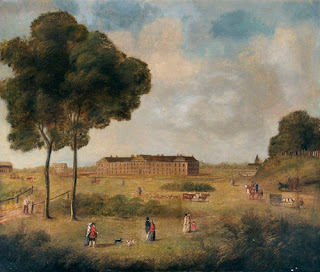During the Georgian period (1714-1830) London witnessed a great expansion of hospital facilities. This article examines a few of the more famous, some of which continue to operate today, though sometimes in different locations and with greatly expanded functions.
In 1721 Thomas Guy, who had made a fortune in the South Sea Bubble, founded Guy's Hospital in Southwark, near London Bridge. He established it to care for "incurables" discharged from nearby much older St. Thomas' Hospital , of which he was a governor.
The St. Thomas governors supported Guy's project by granting him the south side of St. Thomas' Street at a tiny rent for 999 years. St. Thomas' moved from the area to Lambeth, south of Westminster Bridge, in 1871 but Guy's remains in its original location. It has long since expanded greatly in size and remit, and is a major teaching hospital. (Below: Guy's, @1830)
One of the early specialist hospitals, besides the much older Bethlem Hospital for Lunatics, was founded in 1747 by surgeon William Blomfield: the London Lock Hospital for the treatment of syphilis and other venereal diseases. It was originally located near Hyde Park Corner, in Grosvenor Place. It later moved to other premises and developed maternity and gynecological services and other facilities before closing in 1952. The name "lock" derives from earlier leper hospitals. "Locks" were rags used to cover the lepers' skin lesions. (Below: Lock Hospital, mid-18th century)
St. George's Hospital, now in Tooting, was originally located at Lanesborough House, Hyde Park Corner, on its founding in 1733. In 1800, the original structure was demolished and replaced by a larger building designed by William Wilkins (below).
Today, St. George's is one of the major teaching hospitals in the UK. The renowned and controversial surgeon-anatomist John Hunter served as head surgeon at the hospital in the late 18th century. Read about Hunter here: http://mycandles.blogspot.co.uk/2015/10/lopping-them-off-in-leicester-square.html
In 1739, sea Captain Thomas Coram founded Britain's first hospital for abandoned children, the Foundling Hospital. It is believed to be the first incorporated charity. It was located at Lamb's Conduit Fields (now Coram's Fields) in Bloomsbury, and counted William Hogarth, Joshua Reynolds, Thomas Gainsborough, and George Frideric Handel among its benefactors. Among other contributions, Hogarth painted Coram's portrait for the hospital.
The Foundling Hospital was actually an orphanage, with "hospital" used in its ancient sense of hospitality, but medical care of the children was a major function. It moved to the countryside in the early 20th century, and with the shift to adoption and foster care in the 1950's ceased most of its institutional operations. its heritage survives today in Coram, a Children's Charity.
Another major Georgian foundation that continues to function today is the London Hospital, Whitechapel, founded in 1740, now the Royal London. It was established to fill a void: none of the existing hospitals were located in the less fashionable east side of London. Today it is a large teaching hospital. (Below: two images of the hospital building opened in the 1750's.)






